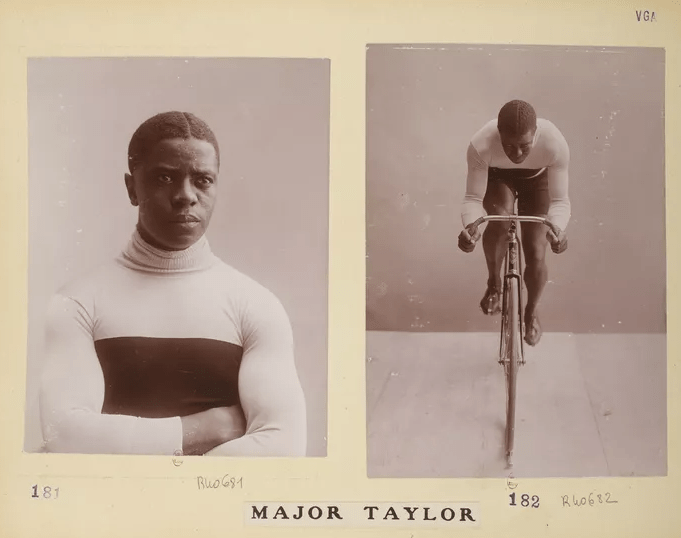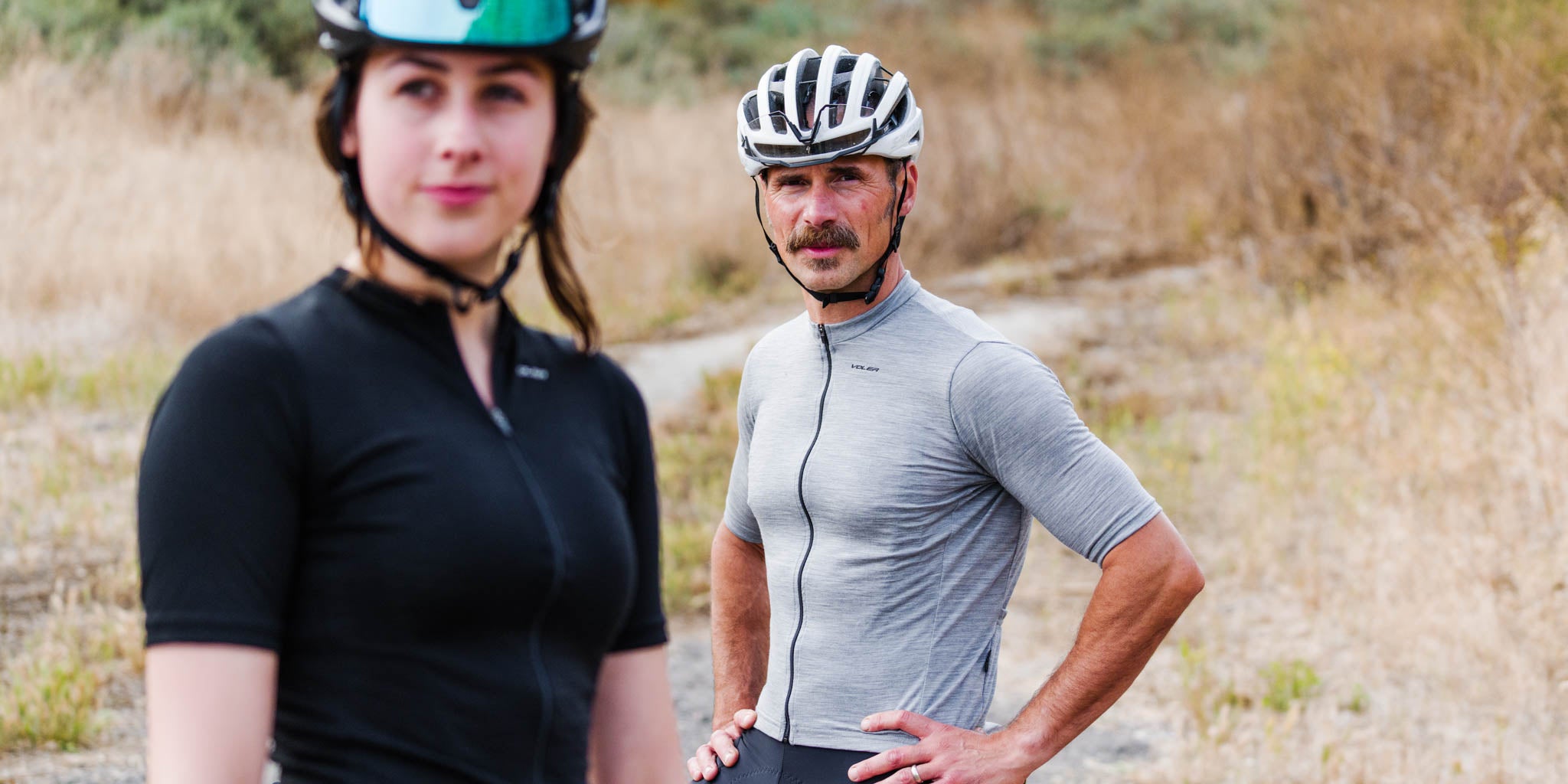A portion of proceeds from the Major Taylor Collection - MEN'S | WOMEN'S - will go to the Major Taylor Association, which is dedicated to preserving and promoting the legacy of one of the world’s greatest cyclists and a trailblazing American hero.

Uncredited newspaper clipping, Major Taylor scrapbook
You’re out on a Sunday ride, rolling toward that favorite climb when up the road, something catches your eye. It’s a rider in a kit with a sleek, contrasting design that’s simple yet bold from afar. Near the top, you pull alongside them, slowing to get a better look at the jersey. A closer look reveals design elements intermingled with phrases and dates.


“Worcester Whirlwind,” “Black Cyclone,” “Ebony Flyer,” “1899,” “Comet”
There’s something deeper going on here. Your interest is piqued. The jersey works its magic, doing exactly what it was intended to do….
For artist, cyclist, and airline pilot Jay OConnor, a jersey is so much more than just a high-tech piece of cloth. To him, a kit is a canvas, an opportunity to inspire - to make an impact. It can give people a different experience on their rides and a chance to educate others they meet along the way. It is an interactive, educational work of art.
The story of Jay’s Major Taylor begins the way many of his design projects do, sitting in the back of a cross-country flight, returning home to Seattle, or heading to work for one of his pilot shifts. “Some people say the sky's the limit, but for me, that’s just the beginning for so many of my ideas and projects.”
There, looking out the window from above 30,000 feet, Jay saw the big picture. He knew his next jersey would be an homage to a great American athlete and the true trailblazing sportsman, Major Taylor.

1897 | Photo by George H. Van Norman
Marshall “Major” Taylor was born in Indiana in 1878 and moved to Worcester, Massachusetts, as a teen. He rose to prominence during the 1890s because of his speed and panache in the world of track bike racing. His talent and drive launched him into a professional career that spanned over a decade. He won the world championship title in 1899, meaning he wasn’t just the fastest man in the world – he was the first American-born Black world champion in any sport. He drew huge crowds and was one of the highest-paid sportsmen of the era.
His results were impressive enough, but the manner in which he achieved them makes this American hero so extraordinary in every sense of the word. The deep racism throughout the US at the time meant that competing was often the most straightforward part of Taylor’s life.

The integrated Boston pursuit team of 1897, left to right: Frank Butler, Burns Pierce, Major Taylor, Nat Butler, Eddie McDuffie. In Taylor's first season as a professional, he was on this team that raced against a team from Philadelphia in July 1897. This is possibly the earliest photo of an integrated American professional sports team. It appeared in Bearings, July 29, 1897, and is held in the Library of Congress.
He often struggled to get a hotel room or even a simple meal on the road. Venues and promoters would oftentimes shut him out entirely. He faced dirty racing and tactics from opponents and, on several occasions, was the recipient of physical violence. After edging out a rider for second in a race, the third-place rider pulled Taylor off his bike and choked him until he was unconscious. That happened in Massachusetts, the state where he lived at the time.
Once he received a death threat in Savannah, Georgia, demanding that he leave town in 48 hours. In those times, in that climate, he took it seriously. There were more lynchings in the United States during the 1890s than any other time in recorded history.
Despite the hideous racism he experienced, he persevered. Throughout all the anger, hate, and aggression that he faced, he remained kind, calm and humble. He was a man of faith and was dedicated to his family and clean living. He loved his country and took pride in representing it around the world, even though many people in it didn’t believe he deserved to even line up at the start. He kept his focus and determination. He did not lash out at the constant injustices he faced. He let his legs do the talking.

Major Taylor training on the Parc de Princes track in Paris in 1901 for his match against French champion Edmond Jacquelin
Photo by Jules Beau / Bibliotheque nationale de France
When he faced bureaucratic machinations that barred him from some organizations and races, he turned his attention to setting records. At one point in his career, he held seven world records, including a time for a paced mile that lasted nearly three decades. His world record for the mile was an average of 45 miles per hour. Only a locomotive went faster than that during that time. No other human had ever traveled that fast under their own power. Crowds loved him for the most part, and in turn, most promoters did too. He was well paid for his talents, secured corporate sponsorships, and became one of the wealthiest Black men in America during that time.
For Jay, the extraordinary story of Major Taylor needed more than just a period-correct look. Instead, he wanted the jersey to function as a cohesive piece of high-performance art, pulling together elements from multiple jerseys that Taylor wore throughout his career.

1898 studio photo by George H. Van Norman
The period-correct button graphics he incorporated on the shoulder are from the kit Taylor wore during his first race in Europe. The argyle pattern on the shorts is from one of his most famous studio portraits in 1898.
The wavey element across his shoulders is from a kit in a historic photo taken in 1897. Taylor posed with four other cyclists, all white men, who were members of a pursuit team formed that year for a special Boston vs. Philadelphia race. This image is one of the earliest known photos of an integrated professional sports team in North America.
The “Comet” emblazoned across the front of the jersey represents the bicycle he rode and raced on when he first arrived in Worcester. The nicknames he earned throughout his career adorn the back of the jersey, and a timeline of his most momentous life and career achievements runs down one of the pockets.

In Major Taylor's first European race, at the Friedenau track in Berlin in April 1901, he faced German champion Willy Arend (center) and Danish champion Thorwald Ellegaard (hidden on right). Uncredited photo, Major Taylor scrapbook.
Major Taylor lived a life that was nothing short of extraordinary. His career was filled with triumph but also rather tragic, considering that his great talent and drive were so blunted by the adversity he faced. He arguably could have won far more races and titles had it not been for circumstances he faced on and off the track. He certainly would not have retired in his early thirties if not for the burnout and mental strain. Every human has their limits, even the most exceptional of us.
But the path he blazed for Black Americans on and off the bicycle is undeniable. And it’s jerseys like Jay O'Connor's homage to Major Taylor that ensure his legacy will continue to spread, one pedal stroke and conversation at a time.
A special thanks to Lynne Tolman of the Major Taylor Association for providing historical context and fact-checking for the design of the jersey as well as this article.
Learn more about Major Taylor here.




